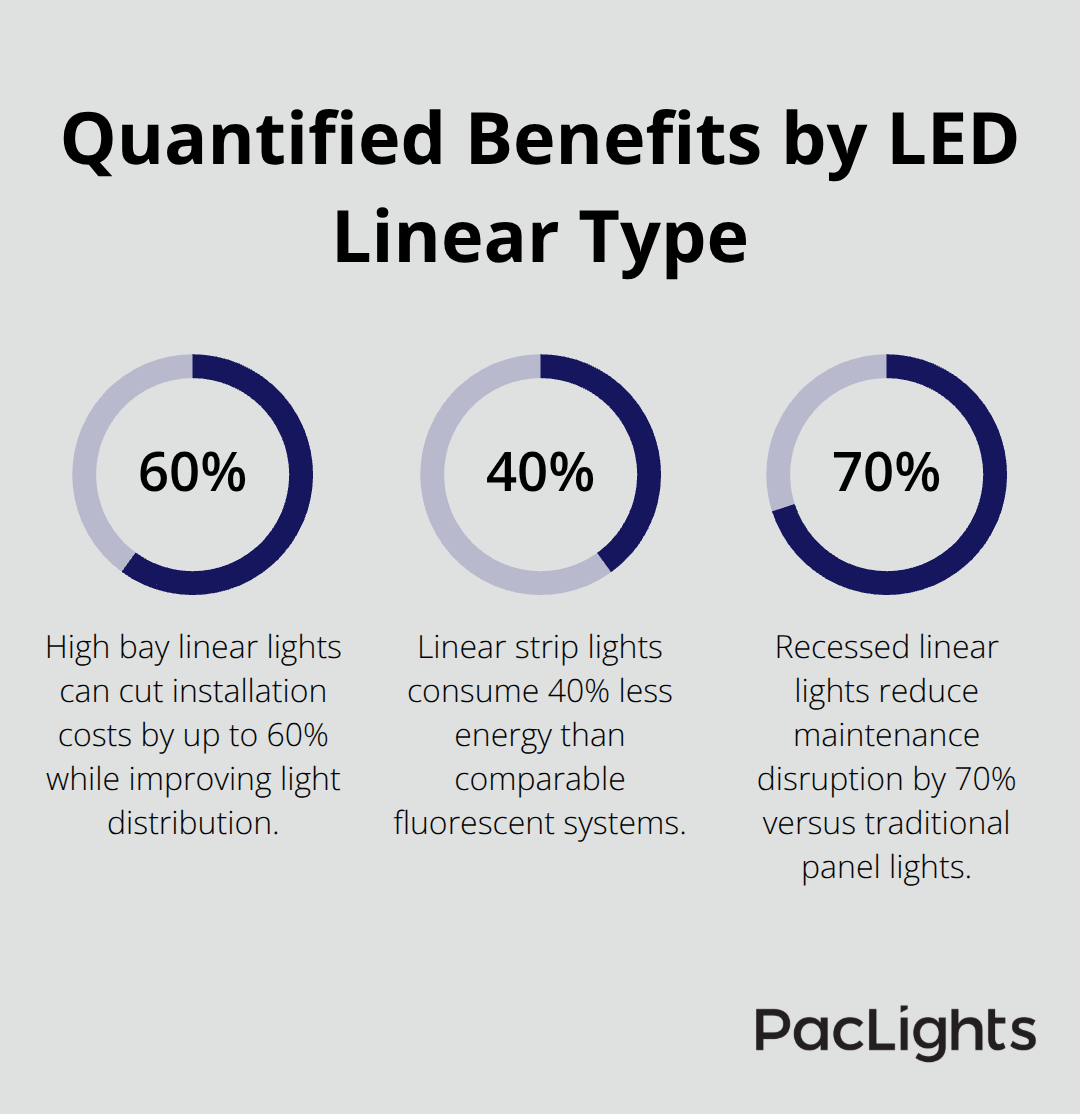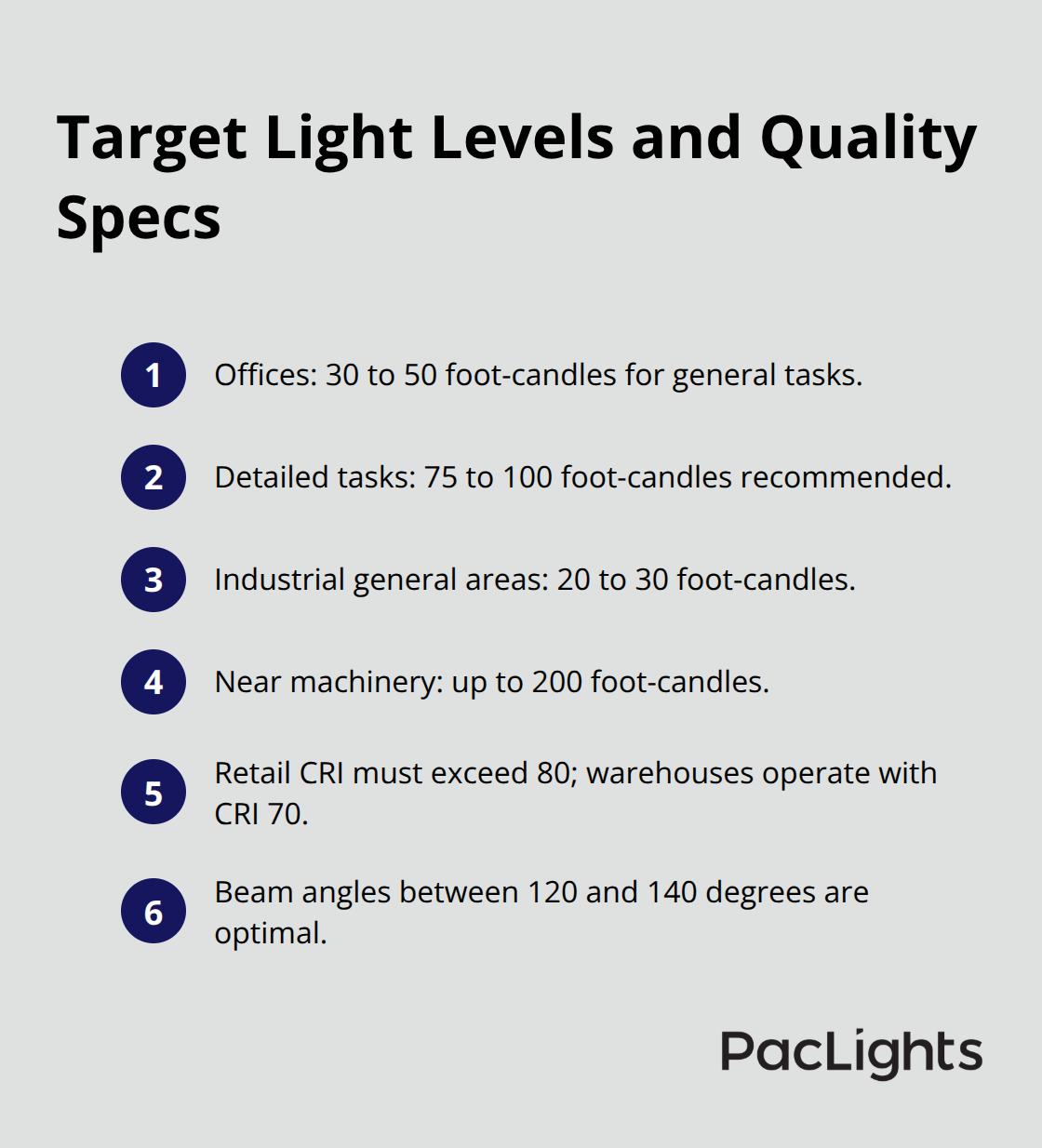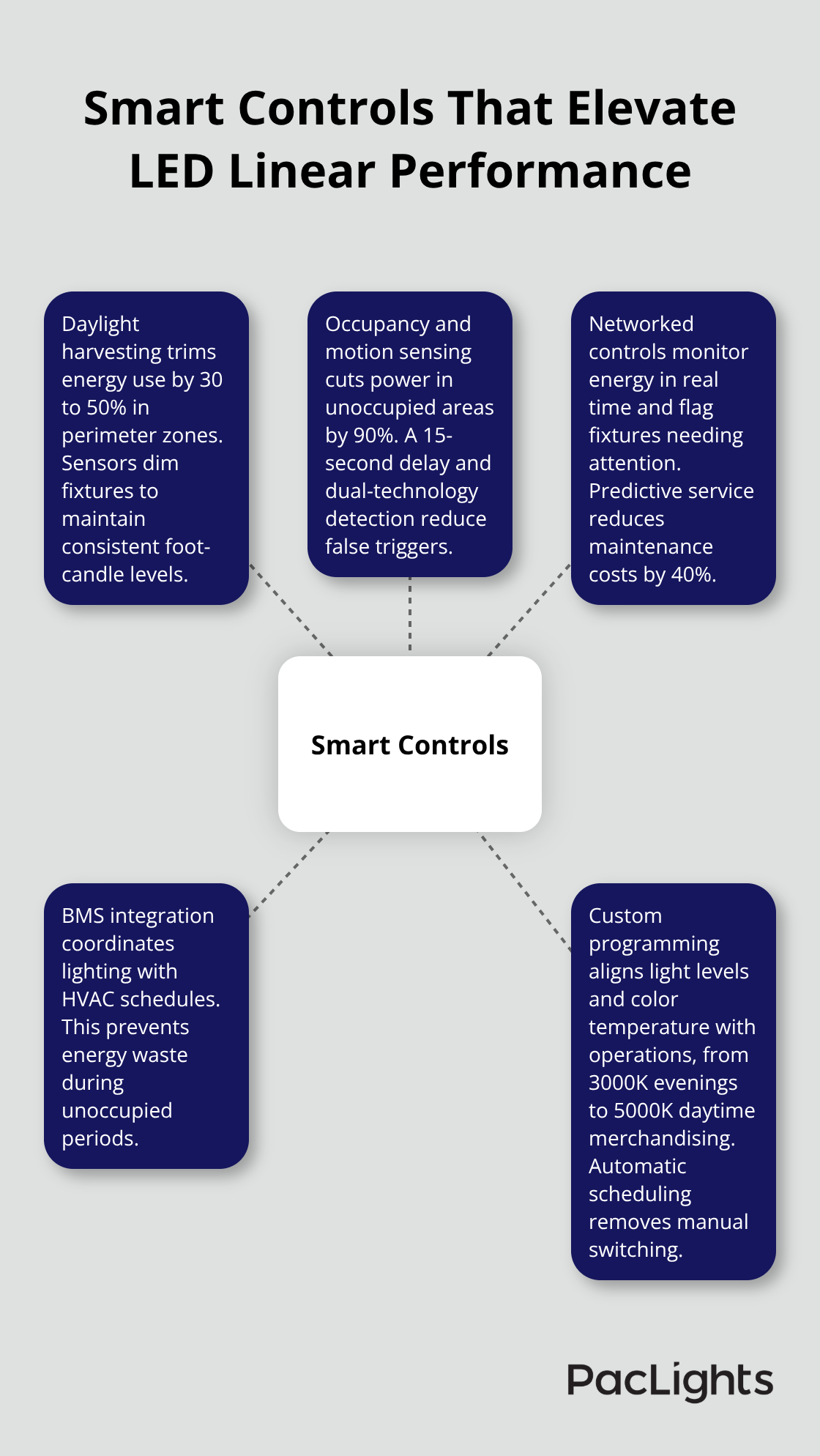LED linear lighting solutions have transformed how businesses illuminate their spaces, offering superior energy efficiency and design flexibility compared to traditional fluorescent systems.
At PacLights, we see companies struggling to navigate the overwhelming array of options available in today’s market. The right choice depends on your specific application, from high-output industrial environments to sleek office installations.
This guide breaks down the essential factors that determine which LED linear lighting solution will deliver the best performance and value for your project.
Which LED Linear Type Fits Your Space
High Bay Linear Lights Dominate Industrial Facilities
Industrial facilities require high bay linear lights that deliver intense illumination across vast areas. These fixtures produce 15,000 to 40,000 lumens and mount 20 to 40 feet above floor level, which makes them perfect for warehouses and manufacturing plants. The key advantage lies in their ability to replace multiple traditional fixtures with fewer LED units, which reduces installation costs by up to 60% while providing superior light distribution. High bay linear lights excel in environments with ceiling heights that exceed 15 feet, where standard fixtures would create dark spots and uneven coverage.

Commercial Spaces Demand Flexible Strip Solutions
Linear strip lights offer unmatched versatility for retail stores, restaurants, and office corridors. These fixtures connect seamlessly to create continuous light runs up to 100 feet long without visible gaps or shadows. The real game-changer is their ability to bend around corners and follow architectural curves (something impossible with traditional fluorescent tubes). Strip lights consume 40% less energy than comparable fluorescent systems while they provide consistent 4000K color temperature that enhances merchandise visibility. Installation takes half the time of conventional systems because strips mount directly to surfaces without complex housing requirements.
Office Environments Require Recessed Integration
Recessed linear fixtures create clean, professional appearances that modern offices demand. These lights integrate flush with ceiling tiles or drywall, which eliminates the bulky appearance of surface-mounted alternatives. The critical factor is their 2-inch to 8-inch width options that accommodate different ceiling grid systems without modification. Recessed linear lights provide uniform task lighting at desk level while they maintain UGR ratings below 19 to prevent computer screen glare (essential for productivity). Their modular design allows easy replacement of individual sections without disruption to entire ceiling installations, which reduces maintenance disruption by 70% compared to traditional panel lights.
These three primary types form the foundation of most commercial and industrial lighting projects, but your specific requirements will determine which additional factors matter most for optimal performance and long-term value.
Key Factors to Consider When Selecting LED Linear Lighting
Light Output and Distribution Requirements
Light output measurements determine whether your LED linear installation will meet workspace requirements. Measure your space in foot-candles rather than lumens because foot-candles account for light distribution across actual work surfaces. Office environments need 30 to 50 foot-candles for general tasks, while detailed work requires 75 to 100 foot-candles. Industrial facilities demand 20 to 30 foot-candles for general areas and up to 200 foot-candles near machinery. The color rendering index must exceed 80 for retail applications where product appearance matters, but warehouses function perfectly with CRI ratings of 70.

Beam angles between 120 and 140 degrees provide optimal distribution for most linear applications.
Energy Efficiency and Cost Savings Analysis
LED linear lights consume 50 to 80% less energy than fluorescent equivalents, but the real savings appear in your monthly utility bills. A 100-fixture installation that switches from T8 fluorescents to LED strips saves $2,400 annually in electricity costs (based on $0.12 per kWh rates). The Department of Energy reports that LED systems maintain 70% of their initial light output after 50,000 hours compared to fluorescent tubes that fail after 20,000 hours. Calculate your payback period when you divide total fixture costs by annual energy savings plus maintenance reduction costs. Most commercial installations achieve payback within 18 to 24 months.
Installation Requirements and Retrofit Options
Existing T-bar ceiling systems accept new LED linear fixtures without structural modifications in 90% of office retrofit projects. Surface-mounted LED strips install directly over old fluorescent housings, which eliminates removal costs and ceiling repairs. The critical factor is ballast compatibility because some LED fixtures work with existing electronic ballasts while others require ballast bypass installation. Ballast-compatible fixtures reduce installation time by 60% but may limit dimming capabilities. Choose bypass installations for maximum performance and control options, especially in spaces where lighting levels need frequent adjustment throughout the day.
These performance specifications and installation considerations set the foundation for your selection, but advanced control features can transform basic LED linear systems into intelligent lighting networks that adapt to your facility’s changing needs.
What Smart Controls Transform LED Linear Performance
Daylight Harvesting Cuts Energy Costs by 30%
Daylight sensors automatically adjust LED linear output based on available natural light, which reduces energy consumption by 30 to 50% in perimeter zones. These photocells measure ambient light levels every second and dim fixtures proportionally to maintain consistent foot-candle levels throughout the day. The California Energy Commission found that buildings with daylight controls save $0.15 per square foot annually in electricity costs. Motion sensors paired with daylight controls deliver even greater savings because they reduce power consumption in unoccupied areas by 90%. Occupancy sensors must have 15-second delays to prevent lights from shutting off during brief absences, while dual-technology sensors combine infrared and ultrasonic detection to eliminate false triggers that frustrate occupants.

Networked Controls Enable Building-Wide Intelligence
Networked systems connect all LED linear fixtures through wireless mesh networks that allow centralized control and monitoring from any internet-connected device. These systems track energy usage in real-time and identify fixtures that need attention before they impact productivity. Facilities reduce maintenance costs by 40% because networked controls predict when fixtures require service based on operating hours and performance data. Advanced systems integrate with building management platforms to coordinate lighting with HVAC schedules, which prevents energy waste during unoccupied periods. Zone-based programming adjusts different areas independently based on usage patterns, time schedules, and occupancy requirements.
Custom Programming Matches Specific Operational Needs
Smart LED linear systems adapt to unique facility requirements through custom programming that traditional lighting cannot match. Manufacturing plants program different light levels for day and night shifts, while retail stores adjust color temperature from 3000K during evening hours to 5000K for daytime merchandise display. Restaurants use preset scenes that transition from bright task lighting during cleaning to warm ambient lighting during service hours (typically 2700K to 3000K for dining areas). Automatic scheduling eliminates manual switching while it maintains optimal conditions for each activity type throughout daily operations.
Final Thoughts
Your facility needs LED linear lighting solutions that match specific performance requirements and installation constraints. High bay fixtures work best for industrial spaces, strip lights excel in commercial environments, and recessed options suit modern offices. Energy savings of 50 to 80% compared to fluorescent systems deliver payback within 18 to 24 months, while smart controls reduce consumption by another 30 to 50%.
Professional layout design prevents shadows and uneven coverage that hurt productivity and safety. Poor fixture placement wastes money and creates performance problems that affect daily operations. We at PacLights provide comprehensive lighting assessments that eliminate guesswork from your selection process.
Start with a complete audit of your current system to document light levels, energy consumption, and maintenance costs. This baseline data enables accurate ROI calculations and helps justify investments to budget decision-makers. The right LED linear solution transforms your space while it delivers measurable cost savings for years to come.


Disclaimer: PacLights is not responsible for any actions taken based on the suggestions and information provided in this article, and readers should consult local building and electrical codes for proper guidance.